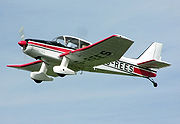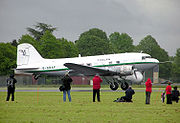
Conventional landing gear
Encyclopedia




Aircraft
An aircraft is a vehicle that is able to fly by gaining support from the air, or, in general, the atmosphere of a planet. An aircraft counters the force of gravity by using either static lift or by using the dynamic lift of an airfoil, or in a few cases the downward thrust from jet engines.Although...
undercarriage
Undercarriage
The undercarriage or landing gear in aviation, is the structure that supports an aircraft on the ground and allows it to taxi, takeoff and land...
consisting of two main wheels forward of the centre of gravity and a small wheel or skid to support the tail. The term conventional persists, having begun in the time when the majority or "convention" of airplanes were thus configured, even though nowadays most aircraft are configured with tricycle landing gear.
The term taildragger is aviation jargon
Jargon
Jargon is terminology which is especially defined in relationship to a specific activity, profession, group, or event. The philosophe Condillac observed in 1782 that "Every science requires a special language because every science has its own ideas." As a rationalist member of the Enlightenment he...
for an aircraft with a conventional undercarriage, although some writers have argued that the term should refer only to an aircraft with a tailskid and not a tailwheel.
History
In early aircraft, a tailskid made of metal or wood was used to support the tail on the ground. In most modern aircraft, a small, articulated wheel assembly is attached to the rearmost part of the airframeAirframe
The airframe of an aircraft is its mechanical structure. It is typically considered to include fuselage, wings and undercarriage and exclude the propulsion system...
in place of the skid. This wheel is steered by the pilot through a connection to the rudder pedals, allowing the rudder and tailwheel to move together.
Advantages
The tailwheel configuration offers several advantages over the tricycle landing gear arrangement.Due to its smaller size the tailwheel has less parasite drag than a nosewheel, allowing the conventional geared aircraft to cruise at a higher speed on the same power. Tailwheels are less expensive to buy and maintain than a nosewheel. If a tailwheel fails on landing, the damage to the aircraft will be minimal. This is not the case in the event of a nosewheel failure, which usually results in propeller
Propeller
A propeller is a type of fan that transmits power by converting rotational motion into thrust. A pressure difference is produced between the forward and rear surfaces of the airfoil-shaped blade, and a fluid is accelerated behind the blade. Propeller dynamics can be modeled by both Bernoulli's...
damage. Tailwheel aircraft are easier to man-handle on the ground and, due to their lower tail, they will fit into some hangars more easily.
Due to the increased propeller clearance on tailwheel aircraft less stone chip damage will result from operating a conventional geared aircraft on rough or gravel airstrips. Because of the way airframe loads are distributed while operating on rough ground, tailwheel aircraft are better able to sustain this type of use over a long period of time, without cumulative airframe damage occurring.
Tailwheel aircraft are also more suitable for operation on skis.
Disadvantages
The conventional landing gear arrangement does have some disadvantages, compared to the nose wheel equipped aircraft.Tailwheel aircraft are much more subject to "nose-over" accidents, due to main wheels becoming stuck in holes or injudicious application of brakes by the pilot.
Conventional geared aircraft are much more susceptible to ground looping
Ground loop (aviation)
In aviation, a ground loop is a rapid rotation of a fixed-wing aircraft in the horizontal plane while on the ground. Aerodynamic forces may cause the advancing wing to rise, which may then cause the other wingtip to touch the ground...
. A ground loop occurs when directional control is lost on the ground and the tail of the aircraft passes the nose, in some cases completing a full circle. This event can result in damage to the aircraft's undercarriage, tires, wingtips and propeller. Ground-looping occurs because, whereas a nosewheel aircraft has its CG (i.e. center of gravity of an aircraft
Center of gravity of an aircraft
The center-of-gravity is the point at which an aircraft would balance if it were possible to suspend it at that point. It is the mass center of the aircraft, or the theoretical point at which the entire weight of the aircraft is assumed to be concentrated. Its distance from the reference datum is...
) ahead of its main wheels, a taildragger has its CG behind the main gear, so that on the ground a taildragger is inherently unstable, whereas a nosewheel aircraft will self-rectify if it swerves on landing. Avoiding ground loops requires increased pilot training and skill.
Tailwheel aircraft generally suffer from poorer forward visibility on the ground, compared to nose wheel aircraft. In some cases this necessitates "S" turning on the ground to allow the pilot to see while taxiing.
Tailwheel aircraft are more difficult to taxi during high wind conditions, due to the higher angle of attack on the wings. They also suffer from lower crosswind capability and in some wind conditions may be unable to use crosswind runways or single-runway airports.
Training
Taildragger aircraft require more training time for student pilots to master. This was a large factor in the 1950s switch by most manufacturers to nosewheel-equipped trainers, and for many years nosewheel aircraft have been more popular than taildraggers. As a result, most PPL pilots now learn to fly in tricycle gear aircraft (e.g. Cessna 172Cessna 172
The Cessna 172 Skyhawk is a four-seat, single-engine, high-wing fixed-wing aircraft. First flown in 1955 and still in production, more Cessna 172s have been built than any other aircraft.-Design and development:...
or Piper Cherokee
Piper Cherokee
The Piper PA-28 Cherokee is a family of light aircraft designed for flight training, air taxi, and personal use. It is built by Piper Aircraft....
) and only later transition to taildraggers..
Techniques
Landing a conventional geared aircraft can be accomplished in two ways.Normal landings are done by touching all three wheels down at the same time in a three-point landing. This method does allow the shortest landing distance but can be difficult to carry out in crosswinds.
The alternative is the wheel landing. This requires the pilot to land the aircraft on the main wheels while maintaining the tailwheel in the air with elevator
Elevator (aircraft)
Elevators are flight control surfaces, usually at the rear of an aircraft, which control the aircraft's orientation by changing the pitch of the aircraft, and so also the angle of attack of the wing. In simplified terms, they make the aircraft nose-up or nose-down...
to keep the angle of attack
Angle of attack
Angle of attack is a term used in fluid dynamics to describe the angle between a reference line on a lifting body and the vector representing the relative motion between the lifting body and the fluid through which it is moving...
low. Once the aircraft has slowed to a speed that can ensure control will not be lost, but above the speed at which rudder
Rudder
A rudder is a device used to steer a ship, boat, submarine, hovercraft, aircraft or other conveyance that moves through a medium . On an aircraft the rudder is used primarily to counter adverse yaw and p-factor and is not the primary control used to turn the airplane...
effectiveness is lost, then the tailwheel is lowered to the ground.
Examples
Examples of tailwheel aircraft include:- Cessna 170Cessna 170|-See also:-External links:* *...
- de Havilland Canada DHC-2 BeaverDe Havilland Canada DHC-2 BeaverThe de Havilland Canada DHC-2 Beaver is a single-engined, high-wing, propeller-driven, STOL aircraft developed by de Havilland Canada, primarily known as a bush plane. It is used for cargo and passenger hauling, aerial application , and has been widely adopted by armed forces as a utility aircraft...
- Denny Kitfox
- Grumman Ag CatGrumman Ag Cat-See also:-References:* Michell, Simon. Jane's Civil and Military Aircraft Upgrades 1994-95. Coulsdon, UK:Jane's Information Group, 1994. ISBN 0 7106 1208 7.-External links:*...
- Maule M-5
- Piper J-3 Cub
- Vans RV-4
Modifications of tricycle gear aircraft
Several after-market modification companies offer kits to convert many popular nose-wheelTricycle gear
Tricycle gear describes an aircraft undercarriage, or landing gear, arranged in a tricycle fashion. The tricycle arrangement has one wheel in the front, called the nose wheel, and two or more main wheels slightly aft of the center of gravity...
equipped aircraft to conventional landing gear. Aircraft for which kits are available include:
- Cessna 150Cessna 150The Cessna 150 is a two-seat tricycle gear general aviation airplane, that was designed for flight training, touring and personal use.The Cessna 150 is the seventh most produced civilian plane ever, with 23,839 aircraft produced...
- Cessna 152Cessna 152The Cessna 152 is an American two-seat, fixed tricycle gear, general aviation airplane, used primarily for flight training and personal use.-Development:...
- Cessna 172Cessna 172The Cessna 172 Skyhawk is a four-seat, single-engine, high-wing fixed-wing aircraft. First flown in 1955 and still in production, more Cessna 172s have been built than any other aircraft.-Design and development:...
- Cessna 175Cessna 175thumb|right|Cessna 175C Skylark The Cessna 175 Skylark is a four-seat, single-engine, high-wing airplane produced between 1958 and 1962.-Production history:The 175 was designed to fill a niche between the Cessna 172 and the faster Cessna 182...
- Cessna 182Cessna 182The Cessna 182 Skylane is an American four-seat, single-engine, light airplane, built by Cessna of Wichita, Kansas. It has the option of adding two child seats, installed in the baggage area....
- Piper PA-22 TripacerPiper PA-20 PacerThe PA-20 Pacer and PA-22 Tri-Pacer are a family of four-place, strut braced, high-wing light aircraft that were built by Piper Aircraft in the post-World War II period....

